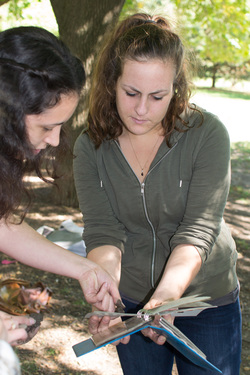
Community-based Soil Quality Assessment as a Tool for Designing an Urban Green Infrastructure Network to Manage Runoff - with Katy Rico, Kate Vollrath, Ellen Webb, Yarency Rodriguez, Allison Williams, and Christian DeKnock
Dr. James Montgomery and Dr. Christie Klimas in the Department of Environmental Science and Studies at DePaul University received a $15,000 grant from USEPA as part of their P3 Program (People-Prosperity-Planet). This funding will support a project in partnership with GCYC and the Greater Grand Crossing neighborhood. This is step 1 of a two-part program. We have the option to apply for additional funds (for an additional 3-years) to implement the project (based on our first year’s findings). If successful, we would receive $90,000 to create plantings/parks in formerly vacant lots in the 5th ward. While there is no guarantee of continued funding, we are hopeful. EPA has different focus areas, and this year green infrastructure (GI), or the idea of using vegetation to minimize pollution, was the focus of our proposal. Our proposal centers on reducing erosion and minimizing the pollutant load of storm water runoff from degraded urban parcels in the Grand Crossing neighborhood via implementation of green infrastructure (GI) projects. The first part of this project (year 1) involves soil testing for nutrients (phosphorus and nitrogen), infiltration (how fast water moves through soil), and various other soil health indicators including microbial activity, density, texture, and perhaps heavy metals including lead, cadmium and arsenic. Using this information, we will create a GIS map of these soil health attributes of different vacant lots, and we will use those attributes to determine suitable types of GI for those sites. Those “suitable uses” could include prairie plantings, educational gardens (especially if it were an area close to a neighborhood school), raised bed gardens, or other vegetation options. While there might be long-term development plans for some of these lots, putting green infrastructure on them for the short-term is still an option. Phase 2, if we receive the funding, would mean that we could implement some of these plans (pending community interest).
This project also includes and educational component. A team of six DePaul students, known as the “P3 Team”, has been assembled and is quite excited about collaborating with Green Teens at GCYC. This builds on a 3-week summer science immersion program that we ran this summer, called Discover DePaul, where ten Green Teens spent a week at GCYC and two weeks on DePaul’s Lincoln Park campus, traveling to different Chicagoland natural areas, and learning the science of soil testing and putting this into practice.
Dr. James Montgomery and Dr. Christie Klimas in the Department of Environmental Science and Studies at DePaul University received a $15,000 grant from USEPA as part of their P3 Program (People-Prosperity-Planet). This funding will support a project in partnership with GCYC and the Greater Grand Crossing neighborhood. This is step 1 of a two-part program. We have the option to apply for additional funds (for an additional 3-years) to implement the project (based on our first year’s findings). If successful, we would receive $90,000 to create plantings/parks in formerly vacant lots in the 5th ward. While there is no guarantee of continued funding, we are hopeful. EPA has different focus areas, and this year green infrastructure (GI), or the idea of using vegetation to minimize pollution, was the focus of our proposal. Our proposal centers on reducing erosion and minimizing the pollutant load of storm water runoff from degraded urban parcels in the Grand Crossing neighborhood via implementation of green infrastructure (GI) projects. The first part of this project (year 1) involves soil testing for nutrients (phosphorus and nitrogen), infiltration (how fast water moves through soil), and various other soil health indicators including microbial activity, density, texture, and perhaps heavy metals including lead, cadmium and arsenic. Using this information, we will create a GIS map of these soil health attributes of different vacant lots, and we will use those attributes to determine suitable types of GI for those sites. Those “suitable uses” could include prairie plantings, educational gardens (especially if it were an area close to a neighborhood school), raised bed gardens, or other vegetation options. While there might be long-term development plans for some of these lots, putting green infrastructure on them for the short-term is still an option. Phase 2, if we receive the funding, would mean that we could implement some of these plans (pending community interest).
This project also includes and educational component. A team of six DePaul students, known as the “P3 Team”, has been assembled and is quite excited about collaborating with Green Teens at GCYC. This builds on a 3-week summer science immersion program that we ran this summer, called Discover DePaul, where ten Green Teens spent a week at GCYC and two weeks on DePaul’s Lincoln Park campus, traveling to different Chicagoland natural areas, and learning the science of soil testing and putting this into practice.
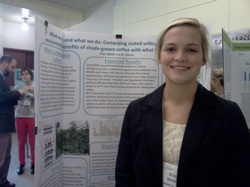
What we say and what we do: Comparing stated willingness to pay for the environmental benefits of shade-grown coffee with what individuals actually pay - Ellen Webb (pictured), Dr. Stanhope and Dr. Klimas
In our global marketplace, individual consumption can lead to environmental degradation that is not always visible to the consumer. Coffee is one example. New high-yield varieties of coffee can be grown in the full sunlight of recently deforested areas. More ecologically friendly shade-grown coffee is grown under forest cover, providing water filtration and species habitat, among other benefits, but has lower yields. Due to the lower yields a price premium is necessary to make it economically competitive with sun-grown coffee. If consumers value the additional ecological benefits they can choose to pay extra for shade grown coffee. Market prices determine how much individuals are willing to pay for a product, or how much they value that product, but using prices becomes more difficult when dealing with goods that are not bought and sold in the market – like the species habitat provided by shade-grown coffee. One way to determine the value individuals place on these non-market goods is to create hypothetical markets using surveys. We used contingent valuation surveys to quantify interest in reducing deforestation with a switch to shade-grown coffee at on-campus coffee shops. Willingness to pay estimated from survey responses was compared to data from a subsequent study where on-campus coffee shops offered shade grown coffee for a price premium.
Article in preparation
In our global marketplace, individual consumption can lead to environmental degradation that is not always visible to the consumer. Coffee is one example. New high-yield varieties of coffee can be grown in the full sunlight of recently deforested areas. More ecologically friendly shade-grown coffee is grown under forest cover, providing water filtration and species habitat, among other benefits, but has lower yields. Due to the lower yields a price premium is necessary to make it economically competitive with sun-grown coffee. If consumers value the additional ecological benefits they can choose to pay extra for shade grown coffee. Market prices determine how much individuals are willing to pay for a product, or how much they value that product, but using prices becomes more difficult when dealing with goods that are not bought and sold in the market – like the species habitat provided by shade-grown coffee. One way to determine the value individuals place on these non-market goods is to create hypothetical markets using surveys. We used contingent valuation surveys to quantify interest in reducing deforestation with a switch to shade-grown coffee at on-campus coffee shops. Willingness to pay estimated from survey responses was compared to data from a subsequent study where on-campus coffee shops offered shade grown coffee for a price premium.
Article in preparation
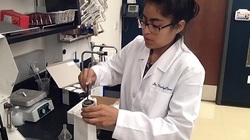
Discover DePaul - with Dr. Jim Montgomery, Xochyl Perez (pictured), Christian DeKnock & 10 Fantastic Green Teens
Discover DePaul is collaborative project initiated by Dr. Jim Montgomery and Dr. Christie Klimas in partnership with the Gary Comer Youth Center (GCYC). This program is funded by the Vincentian Endowment Fund. This was developed as a three-week program (July 8th -July 26th 2013). There were 10 students in the program, and all were involved in GCYC’s Green Teens Program. The Green Teens learn basic horticultural and culinary skills and help manage GCYC’s roof-top and raised-bed gardens. The gardens produce several harvests of vegetables that are sold to local restaurants. The Discover DePaul students visited urban, wetland, prairie and forest sites in the Chicagoland area to take soil samples and learn about the field component of soil sampling. They spent part of the second week in the lab learning how to analyze the data they collected for phosphorus, nitrogren, carbon nitrogen ratio, respiration and heavy metals (particularly lead). They presented their research on the final day of the program.
But equally as important, Discover DePaul introduced students to all facets of university life. They met with reps from Admissions, Financial Aid, Student Life, and other offices. Faculty graciously volunteered their time to give them tours of science labs, and the new nursing simulation lab. It is our hope that Discover DePaul can lead to a permanent “pipeline” of Comer students attending DePaul.
This project also includes a “train the trainer” component. Xochyl Perez (pictured), a recent DePaul ENV graduate was a crucial component of Discover DePaul. She mentored the students, provided advice on what it’s like to be a college student, taught some of the soil modules and worked with the students to collect and analyze the soil samples. The leadership and education experience she gained strengthened her skillset for her anticipated future career in environmental education.
Discover DePaul is collaborative project initiated by Dr. Jim Montgomery and Dr. Christie Klimas in partnership with the Gary Comer Youth Center (GCYC). This program is funded by the Vincentian Endowment Fund. This was developed as a three-week program (July 8th -July 26th 2013). There were 10 students in the program, and all were involved in GCYC’s Green Teens Program. The Green Teens learn basic horticultural and culinary skills and help manage GCYC’s roof-top and raised-bed gardens. The gardens produce several harvests of vegetables that are sold to local restaurants. The Discover DePaul students visited urban, wetland, prairie and forest sites in the Chicagoland area to take soil samples and learn about the field component of soil sampling. They spent part of the second week in the lab learning how to analyze the data they collected for phosphorus, nitrogren, carbon nitrogen ratio, respiration and heavy metals (particularly lead). They presented their research on the final day of the program.
But equally as important, Discover DePaul introduced students to all facets of university life. They met with reps from Admissions, Financial Aid, Student Life, and other offices. Faculty graciously volunteered their time to give them tours of science labs, and the new nursing simulation lab. It is our hope that Discover DePaul can lead to a permanent “pipeline” of Comer students attending DePaul.
This project also includes a “train the trainer” component. Xochyl Perez (pictured), a recent DePaul ENV graduate was a crucial component of Discover DePaul. She mentored the students, provided advice on what it’s like to be a college student, taught some of the soil modules and worked with the students to collect and analyze the soil samples. The leadership and education experience she gained strengthened her skillset for her anticipated future career in environmental education.
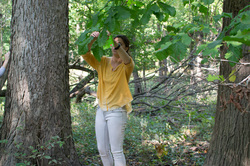
Evanston Green Business Program - Kristen Holdsworth (pictured) and Christina Verrilli
Independent research project that revolves around promoting sustainability through Evanston’s businesses. The City of Evanston is pursuing a goal of reducing 20% greenhouse gas emissions by 2016 (based on 2005 as baseline emissions). A key aspect of reaching this goal is engaging the community through green business initiatives. The position requires conducting research in sustainability initiatives, identifying what others have accomplished and applying methodologies to Evanston.
Independent research project that revolves around promoting sustainability through Evanston’s businesses. The City of Evanston is pursuing a goal of reducing 20% greenhouse gas emissions by 2016 (based on 2005 as baseline emissions). A key aspect of reaching this goal is engaging the community through green business initiatives. The position requires conducting research in sustainability initiatives, identifying what others have accomplished and applying methodologies to Evanston.

Effects of CO2 Enrichment on Biomass Yield, Relative Growth Rate, and Response to Drought In Buckthorn (Rhamnus cathartica) - Erin Lusk (receiving award in photo)
The Midwest region specifically is expected to see warmer average temperatures and less precipitation during the summer because of atmospheric carbon levels. This project was developed to test how buckthorn, an invasive species in the Midwest, grows under conditions of elevated CO2 and drought stress. The prediction was that buckthorn in elevated CO2 would grow more quickly and that it would have better chance of surviving drought. The results of this experiment demonstrated that there was no significant difference in the growth of R. cathartica plants in elevated CO2 levels compared to those in ambient CO2 levels. There was no difference in growth during neither the initial growth period nor the drought growth period.
The Midwest region specifically is expected to see warmer average temperatures and less precipitation during the summer because of atmospheric carbon levels. This project was developed to test how buckthorn, an invasive species in the Midwest, grows under conditions of elevated CO2 and drought stress. The prediction was that buckthorn in elevated CO2 would grow more quickly and that it would have better chance of surviving drought. The results of this experiment demonstrated that there was no significant difference in the growth of R. cathartica plants in elevated CO2 levels compared to those in ambient CO2 levels. There was no difference in growth during neither the initial growth period nor the drought growth period.
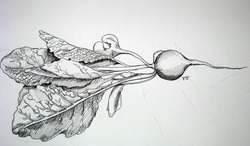
Effects of CO2 Enrichment on Biomass Yield and Response to Drought in Radish and Winter Wheat - Alex Hertel
We examined the effects of elevated CO2 on germination and growth of radish and winter wheat using two growth chambers. After growing for 6-weeks, we drought-stressed the plants to determine whether there was a statistically significant correlation between growth under high CO2 conditions and susceptibility to drought-induced mortality. We saw decreases in susceptibility of winter wheat (Triticum spp.) and radish (Raphanus sativus) grown under elevated CO2 to drought stress, though these results were only marginally significant.
